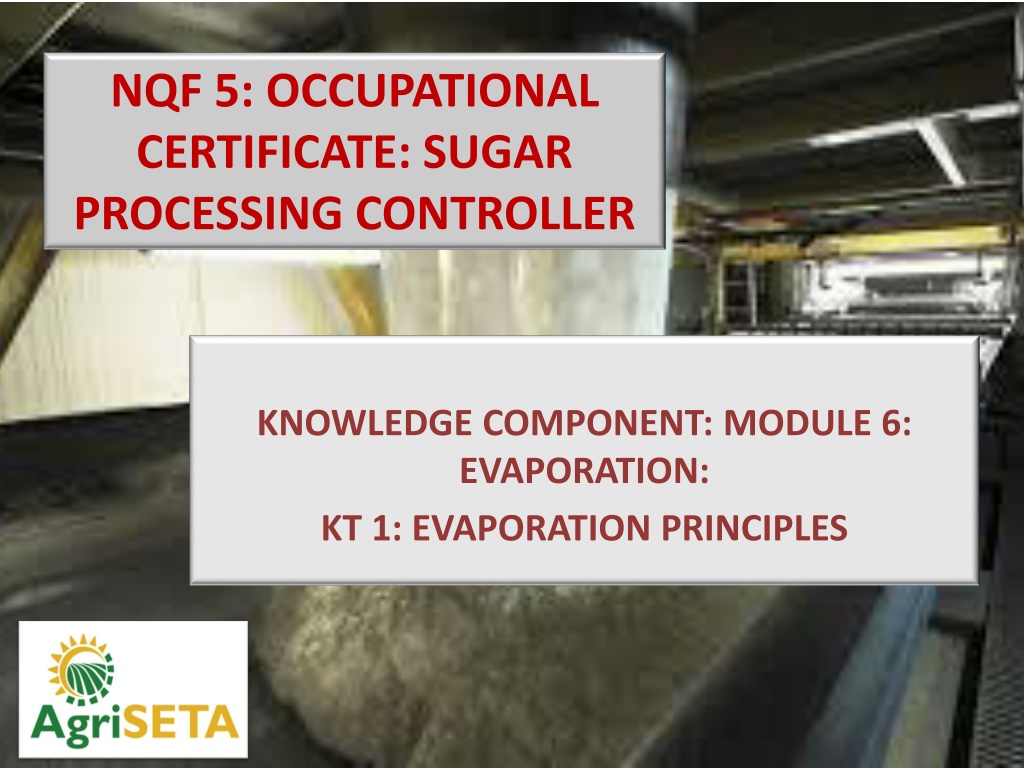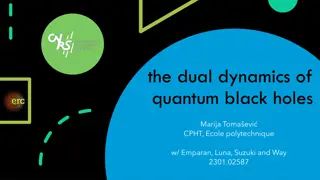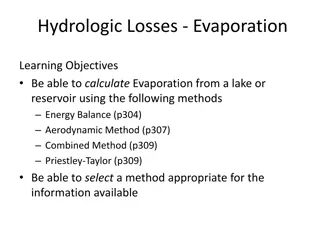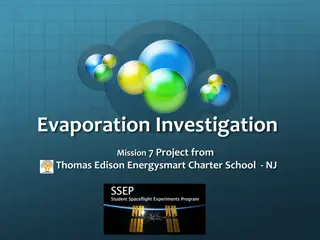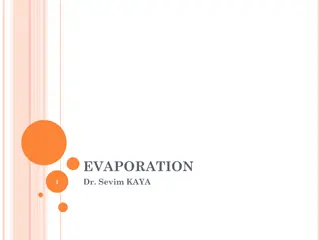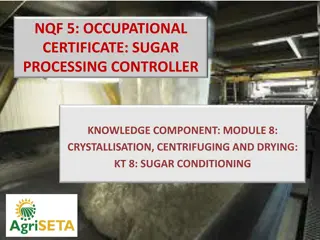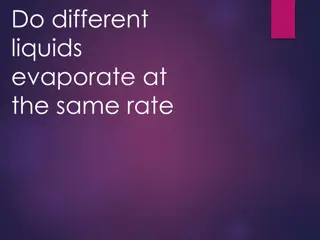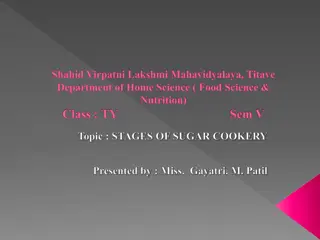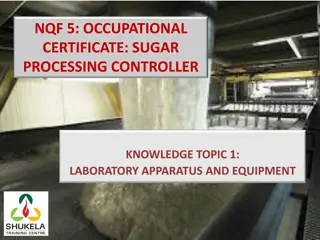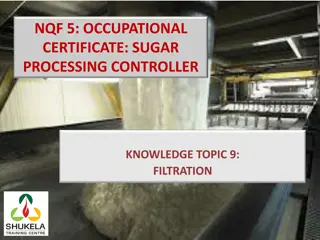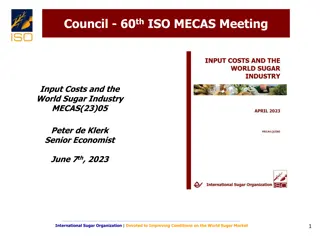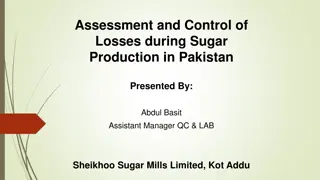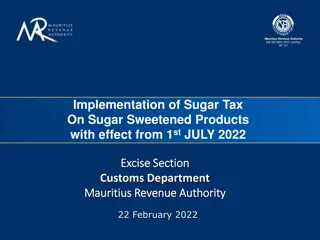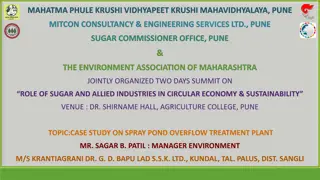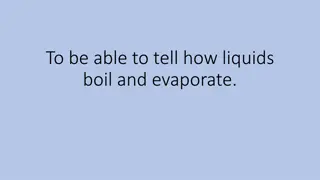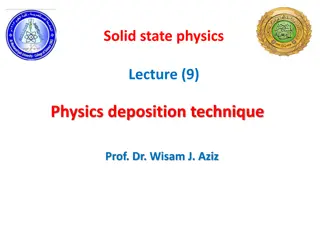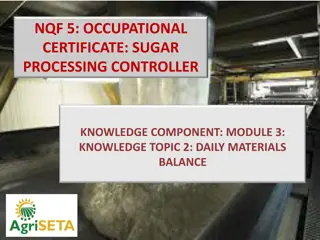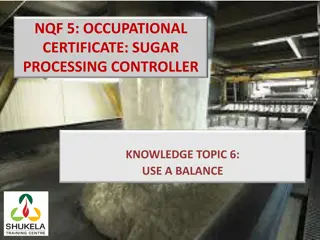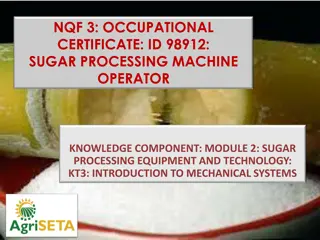Understanding Evaporation Principles in Sugar Processing
Evaporation plays a crucial role in sugar processing by removing water from solutions to concentrate sucrose. This process involves boiling liquor, vaporizing water through heat, and crystallizing sucrose. Learn about the boundary between evaporation and sugar boiling, quantity of water to be evaporated, and key principles involved in the evaporation process.
Download Presentation

Please find below an Image/Link to download the presentation.
The content on the website is provided AS IS for your information and personal use only. It may not be sold, licensed, or shared on other websites without obtaining consent from the author. Download presentation by click this link. If you encounter any issues during the download, it is possible that the publisher has removed the file from their server.
E N D
Presentation Transcript
NQF 5: OCCUPATIONAL CERTIFICATE: SUGAR PROCESSING CONTROLLER KNOWLEDGE COMPONENT: MODULE 6: EVAPORATION: KT 1: EVAPORATION PRINCIPLES
Background Evaporation is the removal of water from a solution by boiling the liquor in a suitable vessel and withdrawing the resulting water vapor. Evaporation is thus carried out by adding heat to the solution to vaporize the water (solvent). The evaporator in its simplest form, would be a closed pressure vessel divided into two sections by a pressure- tight divider. One section is connected to a steam source and the other is partially filled with a solution - juice. If the steam is at a temperature higher than the boiling point of the solution in the other section, two things will occur: The steam will condense and will transfer heat to the solution. The solution will boil which will drive off the solvent. An evaporator is thus a heat exchanger that achieves a phase change on both sides of the heating surface.
Evaporation Principles Clarification removes materials that would interfere with subsequent processing The next step is to eliminate the remaining unwanted component which is water, in order to recover the sucrose As water is removed the sucrose and the other remaining impurities become more concentrated When solution is saturated crystals will begin to appear in the liquid Two stages are required for this process: Evaporation from initial brix of 12 to 65 Sucrose crystallizes evaporative crystallisation
Boundary between evaporation and sugar boiling Sugar begins to crystallise around 78 - 89 Bx Evaporation can be carried out up to 72 - 75 Bx depending on impurities present Sugar boilers require syrup capable of dissolving further sucrose so that false grain can be dissolved Thus, a Bx of 72 is never exceeded Evaporation continues up to 65 - 68 Bx
Quantity of H2O to be evaporated Let: BJ = brix of juice ( Bx) BS = brix of syrup ( Bx) E = mass of water evaporated (mass/time) J =mass of clear juice(mass/time) S =mass of syrup (mass/time)
Pressure and Boiling Point The temperature at which water boils is determined by the pressure on its surface. The boiling point/temperature of a solution is increased by the amount of dissolved substances present in the solution. At 0 Bx pure water boils at 100 C under atmospheric pressure. A 70 Bx sucrose solution boils at 105.7 C under atmospheric pressure. The difference of 5.7 C is called the Boiling Point Elevation (B.P.E) The specific volume of saturated steam at a certain pressure is the volume in cubic metres (m3) of 1kg of saturated steam under that specific pressure. See Steam Tables
Energy Changes during Evaporation At 0 k (-273 C) all substances have zero internal energy/heat. As the temperature of a substance increases above 0 K, the internal energy of the substance increases. The energy that a substance possesses due to its temperature above 0 K is called its sensible heat. At 5 C the sensible heat of water is 137.82kJ.kg-1 and at 100 C the sensible heat of water is 419.04kJ.kg . The energy that a substance absorbs/releases when it changes phase is called its latent heat. At 100 C the latent heat of evaporation of water is 2258.0kJ kg . From 0 K (- 273 C) to 273 K (0 C) water exists as a solid (ice). From 273 K (0 C) to 373 K (100 C) water exists as a liquid. Above 373 (100 C) water exists as a gas (steam)
Single Effect Evaporation Each kg of steam condenses and passes its latent heat to a boiling solution where it evaporates 1kg of water to produce 1kg of vapour. One-to-one evaporation. If the juice feed enters the evaporator below its boiling point, more than 1kg of steam will be required to evaporate 1 kg. If the feed enters superheated, it is possible that the 1kg of steam would produce more than 1 kg of vapour. But, latent heat of evaporation of water decreases as the pressure increases Thus, high pressure steam contains less kJ of heat energy in terms of latent heat per kilogram of steam than the heat energy required to evaporate 1kg of vapour at the lower pressure.
Multiple Effect Evaporation Vapour from a vessel of boiling juice is suitable for use as the source of heat for the next vessel. The vapour from a vessel of boiling juice can thus be passed to the steam chest of a second evaporator, provided the boiling temperature of the contents in the second vessel is sufficiently below the temperature of the vapour to ensure an adequate temperature difference. This is made possible by reducing the pressure and therefore the boiling point in the second vessel. The use of two or more evaporators in series - the vapour outlet of the first vessel being the steam source for the second vessel - is known as multiple effect evaporation. The juice flow is also from the first to the last vessel (forward feed).
Multiple Effect Evaporation (cont.) Quadruple effect evaporator
Multiple Effect Evaporation (cont.) There is a limit to the number of effects it is possible to have. In the sugar industry this limit is usually five (quintuple effect) There is a practical limit to the vacuum that can be drawn using conventional barometric condensers. The temperature-sensitive nature of cane juice places an upper limit on the exhaust steam pressure (temperature) that can be used.
Practically..Single effect Consider the case where we wish to evaporate about 80t of water from 100t of juice to increase its brix from 12 Bx to 65 Bx. This is a single effect evaporation. An amount of 80t steam condenses and evaporates 80t of water. The total amount of water evaporated is 80t and this required 80t of steam.
Practically..Double effect This is a double effect evaporation train. To calculate how much vapour is evaporated in each vessel/effect, we start from the last evaporator and we reason as follows: e tons of vapour is evaporated at Vessel 2, which means that e tons of vapour from vessel 1 was required. Therefore e tons of vapour was evaporated from vessel 1, which means that e tons of steam was used in vessel 1. The result is that the juice moves into vessel 1 where e tons of water is evaporated, after which the juice moves into vessel 2 a further e tons of water is evaporated from the juice.
Practically..Double effect (cont.) Total evaporated: E = e + e E = 2e But the total amount of water evaporated (E) is required to be 80t. This information can be summarized as follows: Thus: 2e = 80 e = 80 2 e = 40 tons
Practically..Triple effect This is a triple effect evaporator train. To calculate how much vapour is evaporated in each vessel/effect, we start from the last evaporator and we reason as follows: e tons of vapour is evaporated at vessel 3, which means that e tons of vapour from vessel 2 was required. Therefore e tons of vapour was evaporated from vessel 2, which means that e tons of vapour from vessel 1 was required. Therefore e tons vapour was evaporated from vessel 1, which means that e tons of steam was used in vessel 1. The result is that the juice moves into vessel 1 where e tons of water is evaporated, then into vessel 2 where another e tons of water is evaporated and finally into vessel 3 where a further e tons of water is evaporated.
Practically..Triple effect (cont.) Total evaporated: E = e + e + e E = 3e But the total amount of water evaporated (E) is required to be 80t Thus: 3e = 80 e = 80 3 e = 26.7 tons This information can be summarised as follows:
And so on.. As the number of effects increases, the mass of steam required for the first effect decreases.
Rillieuxs Principles Rillieuxs first principle: In a multiple effect evaporation on n effects, 1kg of steam fed to the first vessel will evaporate n kg of water from the juice. Rillieuxs second principle: If the vapours are withdrawn from a given effect of a multiple effect evaporator and used outside the boundary of the evaporator system in place of steam, the steam saving will be: Steam saving Number of the effect bled Mass of vapour bled Total number of effects =
Principles in practice.. Rillieuxs first principle: In a multiple effect evaporation on n effects, 1kg of steam fed to the first vessel will evaporate n kg of water from the juice. Under factory conditions this principle is not totally accurate as there are some factors which cause deviations from the principle. Heat is required to raise the temperature of the juice to boiling point. Hence some vapour is condensed without causing an equivalent amount of evaporation. An increase in the latent heat of the vapour as the boiling temperature decreases (i.e. the pressure decreases). The latent heat required to evaporated 1 kg of vapour in the last effect is thus greater than in the first effect.
Example.. Consider the first effect Therefore 1kg of steam condensing does not release enough energy to evaporate 1 kg of water. A decrease in the specific heat of the juice as it is concentrated. This means that less energy/heat is required to raise the temperature of more concentrated syrup by 1 C. Flashing of the juice as it enters a lower pressure vessel causing some evaporation without vapour needing to be condensed to produce the vapour. Flashing of the condensate. Heat lost by radiation and by removal of incondensible gases.
Defining the different effects in an evaporator train A number of vessels may make up a single effect if they are in parallel on the steam side i.e. they share common steam and vapour mains. In this case the juice flow may be either in series or parallel between the vessels in the effect.
Defining the different effects in an evaporator train (cont.) Since evaporators 2A and 2B both receive vapour from the first effect, evaporators 2A an 2B together constitute the second effect. Juice from evaporation 1 can either: Flow into 2A, then into 2B and subsequently to evaporation 3 or Split with part flowing into 2A and the rest into 2B. The juice from 2A and 2B is then combined before flowing to evaporation 3.
Heat Transfer Depends on the temperature difference between the vapour and the juice. The first vessel steam chest/calandria temperature depends on the exhaust steam temperature and is limited by the risk of inversion at high temperatures. The temperature of the syrup in the last vessel depends on the vacuum created in the condenser (Temperature of the cooling water). This is usually limited to 55 C as below this the high viscosity of the syrup causes poor heat transfer. High vacuum and low temperatures increase the risk of entrainment due to the increased volume of vapour.
Heat Transfer (cont.) Low temperatures also increase the supersaturation coefficient which could cause crystal formation. If the exhaust steam at 200kPa absolute pressure has a temperature of 120 C (no superheat) the temperature drop across the evaporator station would be 65 C (120 55 ). In a quadruple effect the average temperature drop per vessel would be 16 C which is good. A quintuple effect would have an average temperature drop of 13 C which is border line. Six vessels would not be a proposition as there would not be enough temperature difference for good heat transfer. Note that the temperature differences between incoming vapour and boiling juice ( T) increases towards the final effects of an evaporator train.
Vapour Bleeding In order to use the least amount of exhaust steam, vapour is bled (drawn off) from one or more effects of a multiple effect evaporator and used to heat juice in the juice heater and heat syrup in the vacuum pans. This achieves an economy in steam usage as the vapour bled comes from the water in the juice. The economy in steam usage will increase as vapour is bled from vessels further down the set i.e. using V2 vapour would show a better saving than using V1 vapour. The use of V3 and V4 is unfortunately impractical as the temperature of these vapours is too low to be used economically. Rillieuxs second principle: If the vapours are withdrawn from a given effect of a multiple effect evaporator and used outside the boundary of the evaporator system in place of steam, the steam saving will be. = Number of the effect bled Mass of vapour bled Steam saving Total number of effects
Vapour Bleeding (cont.) Rillieuxs second principle: If the vapours are withdrawn from a given effect of a multiple effect evaporator and used outside the boundary of the evaporator system in place of steam, the steam saving will be. Steam saving = Number of the effect bled Mass of vapour bled Total number of effects Steam saving = m V n So if the vapour is bled from the 1st effect of a quadruple effect the saving would be 25% of the vapour bled and if the vapour is bled from the 2nd effect the saving would be 50% of the vapour bled. A pre-evaporator is sometimes used to generate vapour purely for juice heaters and pans. The juice then passes on to the conventional multiple effect evaporator.
Calculation to do: . A quadruple effect evaporator train is required to evaporate 80t of water from 100t of juice to concentrate the juice from 15 Bx to 65 Bx Calculate the amount of exhaust steam required by the first effect if no vapour bleeding is used. In addition 10 tons of exhaust steam is required for various heating purposes in the factory. Calculate the total amount of exhaust steam required to supply the heating needs of the factory if no vapour bleeding was used. Calculate the total amount of exhaust steam required if the 10 tons are bled from the first effect evaporator. Calculate the total amount of exhaust steam required if the 10 tons is bled from the second effect evaporator. Calculate the total amount of exhaust steam required if the 10 tons is bled from the first effect and 10 tons is bled from the second effect.
Chemical changes during evaporation Increase in purity Reducing sugar ration (the ratio of reducing sugars to pol) Precipitation of non-sugars Sucrose decomposition : Inversion Degradation of reducing sugars Colour formation Change in pH
Chemical changes: Increase in Purity Under normal conditions there should be a slight increase in purity from clear juice to syrup. This increase in purity is as a result of: A change in the specific rotation of certain non-sucrose components specifically reducing sugars under the influence of temperature Precipitation / removal of some non-sugars.
Chemical changes: Reducing sugar ratio Under normal conditions, a clear juice with a good pH (7.0 7.4) will record a small decrease in the reducing sugar ratio of between 4 6% from clear juice to syrup. Decrease is greater when the juice has been over-limed during the clarification stage. Large decrease in the reducing sugar ratio indicates destruction of reducing sugars. Increase in the reducing sugar ratio or a reducing sugar ratio that remains constant indicates inversion. CHANGE IN REDUCING SUGAR RATIO
Chemical changes: Precipitation of non- sugars The syrup, if diluted, has an increase in turbidly over that of clear juice. Due mainly to the post precipitation of certain non-sugars because of the high temperatures in the first evaporator vessel. Non-sugars include silica and organic compounds.
Chemical changes: Sucrose decomposition : Inversion Inversion is the thermal and/ or acid decomposition of a sucrose solution to yield a mixture of glucose and fructose. More marked the higher the temperatures, lower pH and the longer the time of exposure. Rate is affected by pH, temperature and time. Directly proportional to the time. Proportional to the H+ ion concentration (acidity). The rate increases tenfold for every 1 unit decrease in pH. At 100 C and pH of 7.0 the rate is 0.021% inverted per hour. At pH of 6.0 the rate will increase to 0.21% inverted per hour. Icreases rapidly with increase in temperature. If the inversion at 100 C is 1.00 then the the rate at 120 is 5.23 times faster.
Chemical changes: Sucrose decomposition : Inversion (cont.) See Temperature and Time Inversion Tables Under normal operating conditions it is difficult to determine analytically the exact amount of sucrose that has been inverted as the process steams already contain amounts of reducing sugars. An increase in the reducing sugars ratio would normally be indicative of sucrose destruction by inversion. An assessment of the potential sucrose losses where no information on operating temperature or pH (measured at operating temperature) is available, is possible using changes in the reducing sugar ratio, preferably the glucose ratio. Acid juice and high temperatures in the first and second vessels are conducive to inversion of sucrose to glucose and fructose.
Chemical changes: Degradation of reducing sugars Is a function of pH, temperature and reaction (retention) time. Alkaline juice and high temperatures in the first and second vessels are conducive to the degradation of glucose and fructose and the formation of organic acids and dark coloured compounds. These products cause viscosity problems later on in the process. A decrease in the reducing sugar ratio results mainly from the destruction of reducing sugars. Destruction increases with temperature, increases with the time and increases as pH increases.
Chemical changes: Colour Formation Main sources of colour in evaporator syrup are formed in the sugar cane itself The amount present is dependent on cane age, level of stress (drought) and the amount of extraneous matter crushed. The darkening of final syrup is largely a result of concentrating the colour bodies already present. A certain amount of colour can be formed in the evaporator by the degradation products of reducing sugars. This is evident by the increase in colour observed in diluted syrup. Colour formation occurs mainly in the first vessels of the evaporator which correspond to high temperatures and slightly alkaline or neutral conditions. Suitable pH control and short retention times in these effects have brought this under control. Under alkaline conditions, reducing sugars break down to form colour compounds (melanoidin pigments)
Chemical changes: Change in pH During evaporation pH decreases from a value typically around 7.0 to 7.2 to a value of 6.3 to 6.5 but may in some cases drop as low as 5.5. This drop in pH is due to the following factors: As evaporation progresses, the existing acids become more concentrated, making the solution more acidic. Decomposition of reducing sugars to form organic acids. Loss of alkaline volatiles such as ammonia. Thus, a combination of high concentration and high temperature will produce conditions of low pH and thus increased inversion.
